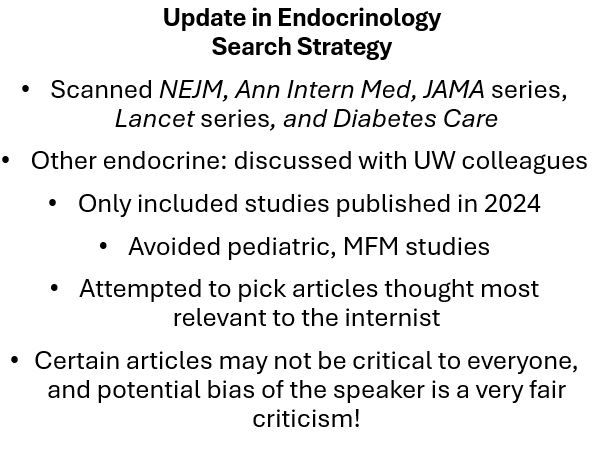Research That Is Changing Endocrinology: Advances, Challenges, and The Future, with Irl B Hirsch, MD
ACP 2025: Irl B Hirsch, MD, reviewed findings from 8 papers published in 2024 that he believes have made or will make a difference in the practice or understanding of the clinical area.
At the American College of Physicians Internal Medicine Meeting 2025, April 3-5, in New Orleans, LA, Irl B Hirsch, MD, professor of medicine, division of metabolism, endocrinology, and nutrition, at the University of Washington School of Medicine, Seattle, WA, provided a comprehensive review of the 8 studies he feels will have the greatest lasting impact on clinical practice. Hirsh's choices covered diabetes treatment, lipid management, and women’s health, among other topics.

Endocrinology Workforce Shortage and Its Consequences
Hirsch began the presentation by placing endocrinology access in context, pointing out a concerning trend. Currently, nearly 70% of US counties lack an endocrinologist, leaving 50 million Americans without in-county specialty care. Data indicate that individuals living in these "endocrinologist deserts" face a 12% higher mortality rate from endocrine-related conditions and higher incidences of diabetes, obesity, and stroke. The shortage stems largely from economic burdens, Hirsch explained, including high medical school debt and relatively lower salaries compared to general internal medicine.
Women’s Health: Fezolinetant for Vasomotor Symptoms
Vasomotor symptoms, affecting up to 80% of menopausal women, have historically been managed with hormone therapy, which is not appropriate for all women. Hirsch reviewed research supporting fezolinetant, a neurokinin 3 receptor antagonist approved in 2023, which provides a non-hormonal alternative. A study published in BMJ1 demonstrated significant reductions in symptom severity and sleep disturbances over a 6-month period, suggesting a promising new option for patients ineligible for traditional hormonal therapy or who prefer not to use them.1
Lipoprotein(a) and the Promise of Muvalaplin
Lipoprotein(a) [Lp(a)], a β-lipoprotein, has long been recognized as an independent risk factor for cardiovascular disease (CVD), by some estimates doubling or even tripling the risk for myocardial infarction. Its role as a modifiable risk factor, however, has remained uncertain. Muvalaplin, a first-in-class agent designed to lower Lp(a) levels, showed a reduction of the lipoprotein up to 85.7% in a phase 2 trial published in JAMA.2 Whether significant drops such as this one translate into reduced risk for cardiovascular events requires further investigation, Hirsch said.

Testosterone Replacement Therapy and Bone Health
Moving on to bone health in men with testosterone deficiency, Hirsch reviewed a subtrial of the Traverse Bone Fracture Trial, published in NEJM,3 which evaluated testosterone replacement therapy (TRT) in hypogonadal men. Contrary to expectations, the time-to-event analysis revealed that TRT did not reduce fracture risk; in fact, the incidence of fractures was numerically higher in the treatment group.3 The predominant explanation for this paradoxical finding was behavioral—men receiving TRT engaged in more aggressive physical activities, leading to an increase in trauma-related fractures. Support for the hypothesis, Hirsch explained, could be seen in the fact that typical osteoporotic fractures (ie, see in the hip, spine, wrist) were no different between the treatment and placebo groups.3
Testosterone and Cardiovascular Disease Risk in Men
Hirsch found a second study on men’s health, this one on testosterone and cardiovascular disease, worth highlighting. A meta-analysis of 30 trials involving 11,502 participants examined the effects of testosterone replacement therapy on cardiovascular outcomes.4 The study, published in Prog Cardiovasc Dis found no significant differences in major cardiovascular events, stroke, myocardial infarction, all-cause mortality, or cardiovascular mortality between men receiving testosterone and those on placebo.4 These findings suggest that TRT does not appear to increase cardiovascular risk, providing reassurance regarding its cardiovascular safety profile.4
GLP-1 Receptor Agonists: Diabetes Prevention and Kidney Protection
Glucagon-like peptide-1 receptor agonists (GLP-1RAs) continued to make headlines in 2024, and Hirsch selected 2 studies as notable. A landmark trial published in NEJM 5 demonstrated that semaglutide significantly reduced the relative risk for a composite endpoint of major kidney disease events by 24% in patients with type 2 diabetes and chronic kidney disease.5 The findings led to a label expansion for semaglutide in early 2025 for kidney disease risk reduction.
Tirzepatide, a dual GIP (glucose-dependent insulinotropic polypeptide) and GLP-1 receptor agonist, was shown to prevent the progression of prediabetes to type 2 diabetes. Hirsch reported the notable findings from the SURMOUNT-1 study, also published in NEJM.6 The study included more than 2500 adults with obesity, including 1,032 with prediabetes, and found a 93% risk reduction in conversion from prediabetes to frank type 2 diabetes over a 3.4-year period. In addition, the average weight loss from study baseline to week 176 as 15.4% (5 mg), 19.9% (10 mg) and 22.9% (15 mg) compared to placebo (2.1%),6 Hirsch noted.
GLP-1RAs and Thyroid Cancer: Addressing Safety Concerns
The association between GLP-1RAs and medullary thyroid carcinoma (MTC) has been a concern since before the approval of the first GLP-1RA and earned a boxed warning on the full class of medications. The warning is based on preclinical studies that signaled stimulation of thyroid C-cells, potentially increasing the risk of MTC. Studies in humans have been inconclusive. Hirsch highlighted a large cohort 2024 study in BMJ7 of 145,410 adults on GLP-1RAs and 291,667 on DPP-4 inhibitors that found no substantial increase in MTC risk over a 3.9-year follow-up. Similarly, a JAMA Network Open8 study reported that GLP-1RAs were associated with a lower incidence of obesity-associated cancers compared to insulin and metformin.
Diabetes Technology: Continuous Glucose Monitoring (CGM) and Automated Insulin Delivery (AID)
Hirsch was particularly animated in his discussion of the continued improvement in diabetes monitoring technology and the improved outcomes associated with them. He reviewed 2 novel CGM sensors introduced in 2024 that have the potential to expand CGM use beyond diabetes to prediabetes and metabolic health monitoring, according to study findings published in JAMA.9 He also touched on a study from Diabetes Care10 that compared closed vs open loop pumps in type 1 diabetes treatment that found reductions in mean sensor glucose and HbA1c of 26 mg/dL and 0.58% with an automated insulin delivery device vs open loop pump, respectively (P <.001 for both).
Looking to 2025
Hirsch concluded by previewing key developments expected in 2025, including:
- Studies on AID systems in type 2 diabetes
- Improved dual and triple agonists targeting GLP-1, GIP, and glucagon
- More real-world data on GLP-1RAs and thyroid cancer risk
- Advances in stem cell therapies for type 1 diabetes
The past year brought significant advancements in endocrinology, particularly in diabetes treatment, lipid management, and women’s health. However, the growing disparity in endocrinology access remains a pressing issue. Internists will increasingly need to manage complex endocrine disorders, reinforcing the importance of continued education and technological adoption in clinical practice, Hirsh added.